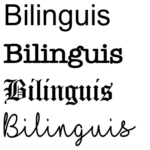
If you’re a voracious reader who’s learning Spanish, chances are you’ve already discovered the beauty of using Spanish literature for language practice.
Reading in Spanish can help you improve your grammar and sentence structure and it can introduce you to a wide variety of vocabulary words.
In other words, reading Spanish-language texts is a great way to fast-track your Spanish fluency.
The stories and resources in this article solve these problems. Here, you’ll find four stories and six free websites with Spanish stories and books—that have English translations. Each website has unique features and content that correspond to particular tastes and ability levels.
Contents
Download:
This blog post is available as a convenient and portable PDF that you
can take anywhere.
Click here to get a copy. (Download)
Excellent Spanish Stories with Translations
Reading stories in Spanish that have accurate and nuanced accompanying translations can turn your reading experience from confusing and frustrating to fun and effective. Here’s our list of entertaining and well written Spanish stories, so you can get straight into the narratives and characters without worrying about anything else.
This short story reimagines the biblical story of Mark’s gospel, and it’s available in English translation.
This story written for children is excellent for beginners.
A super entertaining short story, the author plays with narrative perspectives, and it’s available with an English translation.
This is a classic short story by a giant in Spanish language literature, and it’s available with an English translation.
Resources to Find More Spanish Stories with Translations
The stories above are a good start, but you’re going to want to find stories with narratives and characters that appeal to you. To make that search easier, check out these six helpful and free resources:
1. The Spanish Experiment
Level: Beginner

Have you ever heard of “Pollito Tito” or “Ricitos de Oro”? If not, then I can guarantee you’ve heard of their English counterparts: “Chicken Little” and “Goldilocks.”
On The Spanish Experiment, you can read Spanish-English versions of five children’s stories that you’ll definitely remember from your own childhood. Plus, through the website’s partnership with The Fable Cottage, they’ve recently added four additional stories, including classics like “Jack and the Beanstalk” and “Hansel and Gretel.”
What The Spanish Experiment lacks in breadth, it makes up in quality. Each of the stories is beautifully written and comes with a multitude of features so you can play around with your reading experience.
Each story is presented in Spanish. At the end of each short paragraph, you’ll see a “Translate” button. The translation of each paragraph remains hidden until you want to see it, which can be great for learners trying to flex their memorization and vocab muscles. Or, you can choose to “show all translations” at the beginning of the text, and read the English and Spanish versions side-by-side.
Some of the stories, such as “Jack and the Beanstalk,” provide two options: “Translate” and “Literal.” The “Translate” button will give you a literary English translation that captures the meaning of the whole paragraph. But the “Literal” button will provide word-by-word translations in case you’re struggling with a particular phrase.
2. Snappy Spanish
Level: Beginner-Intermediate

Snappy Spanish is great for on-the-go learners who only have a few minutes each day to devote to language-learning. Each of their stories is meant to be read in five minutes or less.
Unlike The Spanish Experiment, Snappy Spanish doesn’t focus on Spanish-English retellings of popular fairy tales. Instead, these stories are more like what you might find in a Spanish textbook: short, original stories about a variety of topics.
While that means that these stories are less immediately accessible than more well-known stories, it also has some advantages. Original stories test a reader’s ability to follow an unfamiliar plot, relying only on their language skills. Plus, these stories touch upon a wider variety of vocabulary and include more verb tenses than you could expect to find in a typical fairy tale.
3. Learn Spanish with Bilingual Stories
Level: Intermediate-Advanced
Some people say that if you want to do something right, you have to do it yourself. This charmingly home-grown website is a labor of love by one enthusiastic linguist and translator.
The owner of the website has painstakingly matched Spanish and English translations of literary classics. You can find great works like “Dracula,” “Frankenstein” and “The Strange Case of Dr. Jekyll and Mr. Hyde.” In some cases, such as this Edgar Allen Poe short story, the website’s creator has even tracked down two alternative translations, so that readers can compare word choice and sentence structure.
This kind, anonymous soul has also taken the time to color-code each translation to make it easier to follow. Certain sentences, which are metaphorical, literary or otherwise tricky have been highlighted in color and matched with the same sentence in the translation. This is a godsend for readers who struggle with non-literal Spanish phrases.

Of course, the self-styled nature of the website has its drawbacks. Some works are incomplete. (For example, “Dracula” has only been translated through Part One.) Some texts have side-by-side translations, whereas others go sentence-by-sentence. And the website’s display can be a bit hard to read, though the website creator suggests that this can be made easier with a browser extension called Readlang.
4. Grimms’ Fairy Tales
Level: Beginner-Intermediate
Ready for more children’s stories? This website offers a complete collection of the fables written by the Brothers Grimm. This means you can find famous fables you’ve definitely heard of (like “Rumpelstiltskin”) as well as some deep cuts (anyone ever heard of “King Thrushbeard”? I haven’t).

The website has English and Spanish versions (not to mention tons of other language options) for each fable. Since this isn’t technically a Spanish-learning website and these aren’t designed as parallel texts, the experience with Grimms’ Fairy Tales is a bit more DIY than the other offerings on this list.
To start, go to the complete list of Grimm fairy tales in English and in Spanish. You’ll notice that each fairy tale has a number from one to 200. The tales are in the same order on both lists, so simply pick a number and you’ll be able to easily find the Spanish and English versions. If you’re having trouble picking, you can always use the “Story at random”/“Cuento al azar” option to get a random story in Spanish or English, and then navigate to the translation yourself.
5. bilinguis.com

Level: Intermediate-Advanced
bilinguis.com offers a small but well-curated selection of classic literature, translated into multiple languages.
The site makes fewer mistakes than most do, and it has no annoying computer-generated audio, so you can just focus on reading.
bilinguis.com only offers a split view, but it’s very easy to read and compare the two texts.
6. Childhood Stories

Level: Beginner-Intermediate
When you’re first starting out reading in a second language, stories written for children is a great place to start. They use simple language and vocabulary that’s less intimidating for language learners.
They also happen to be a lot of fun. After all, they’re written to entertain children.
This site includes a lovely collection of stories including classics like Aesop’s Fables, with reliable English translations.
Reading Spanish stories with English translations is a great way to improve your grammar skills and vocabulary recall. Plus, parallel texts make it easy to start reading in Spanish at any level.
So, whether you’d rather read a cute children’s story or revisit your favorite classic novel, it’s a fantastic idea to add reading to your language-learning routine.
Which story will you tackle first?
Download:
This blog post is available as a convenient and portable PDF that you
can take anywhere.
Click here to get a copy. (Download)



